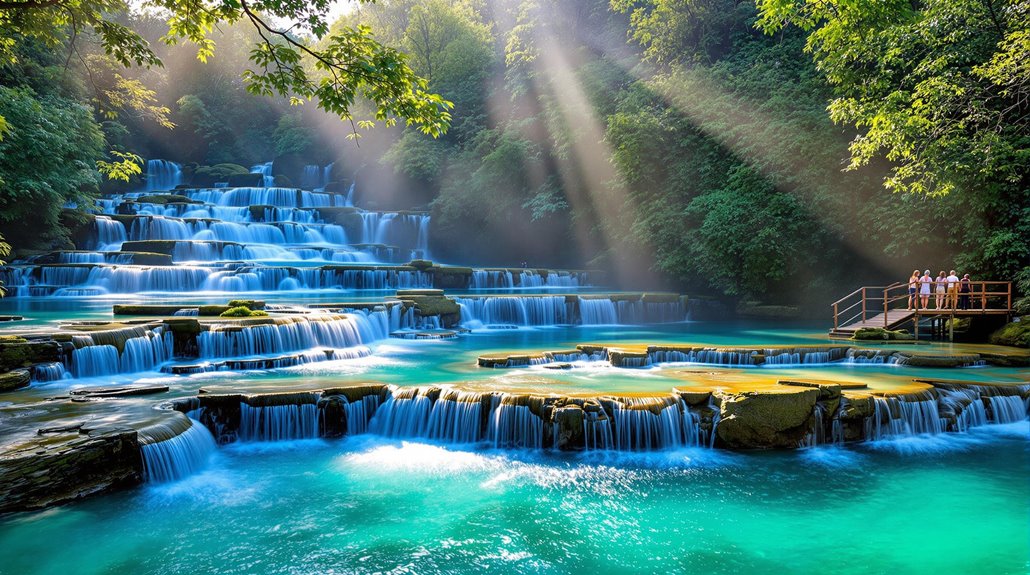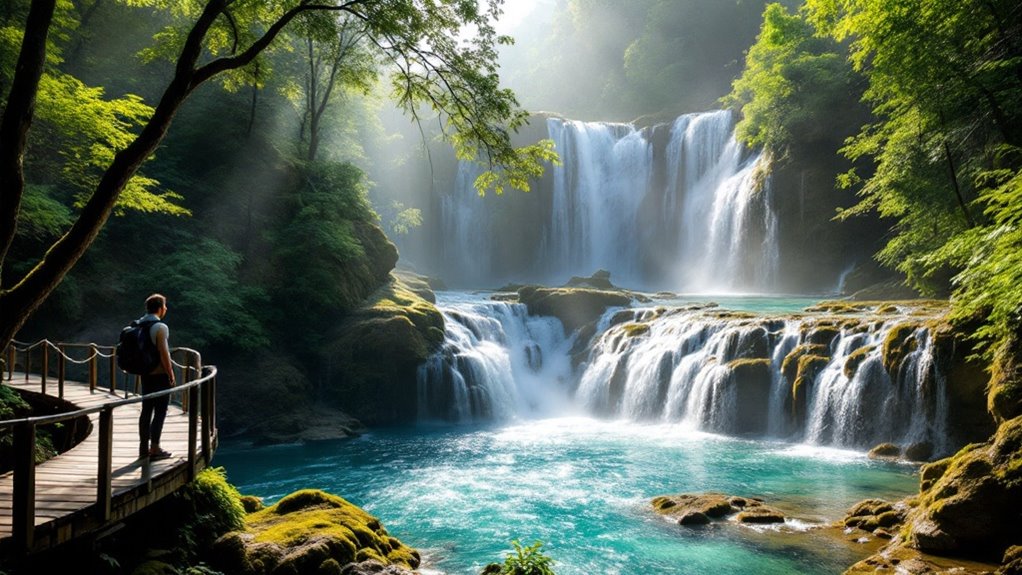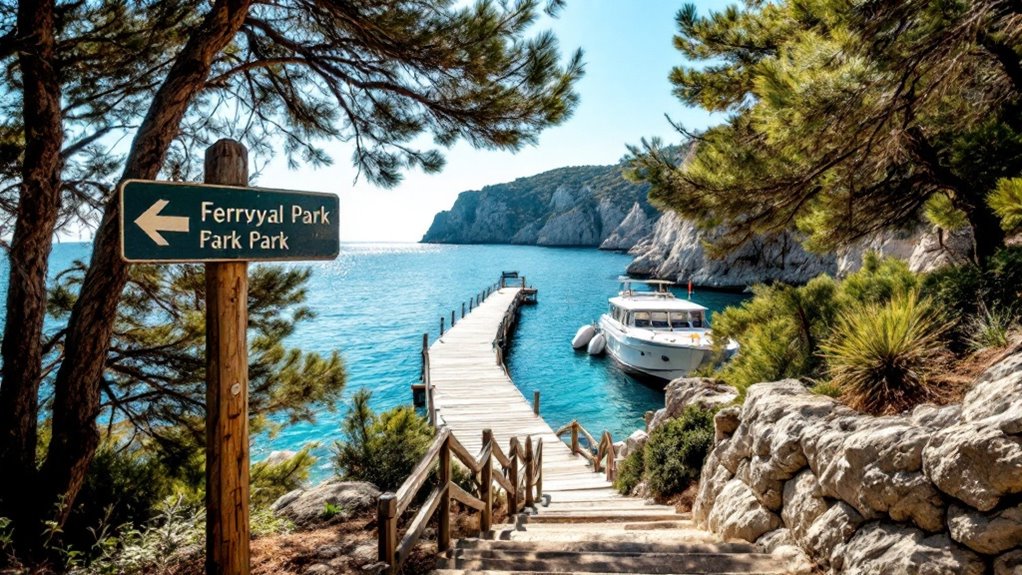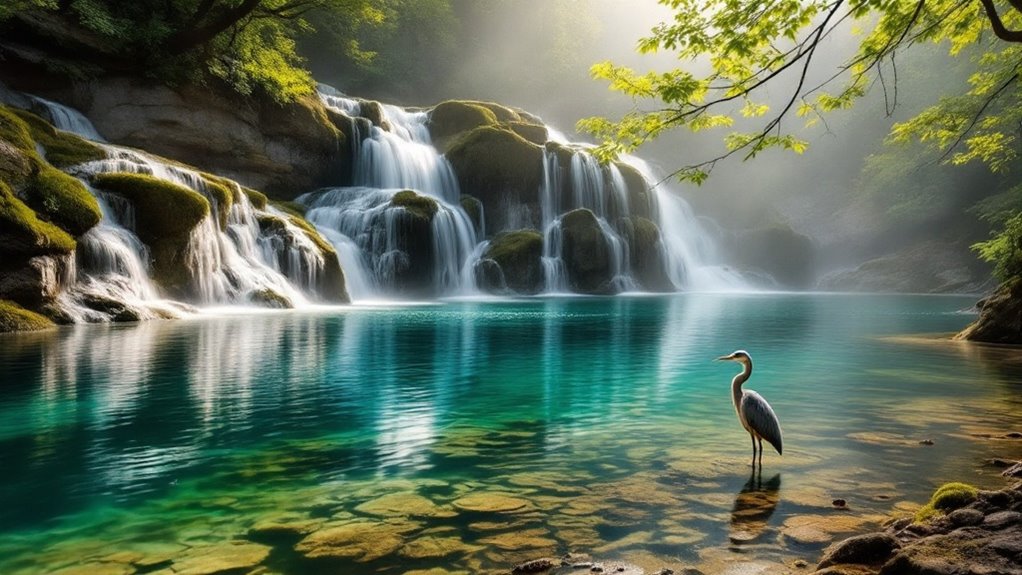Physical Address
304 North Cardinal St.
Dorchester Center, MA 02124
Physical Address
304 North Cardinal St.
Dorchester Center, MA 02124

Just as you're planning your Croatian adventure, Krka National Park has emerged as one of Europe's most enchanting yet manageable natural wonders. You will discover this gem of the Dalmatian coast offers the perfect blend of accessibility and raw beauty, with its network of waterfalls, hiking trails, and historic sites. While stunning photos might have sparked your interest, they don't capture the full experience of standing before the thundering Skradinski Buk or spotting an eagle soaring overhead. Let's explore what makes Krka truly special.

When should you plan your visit to Krka National Park? For the best experience, aim for May, June, September, or October.
You'll enjoy mild temperatures between 15-25°C and encounter fewer crowds, plus you'll save money on tickets compared to peak season.
If you're on a tight budget, consider visiting between November and March when adult tickets cost just €7, though some facilities will be closed.
Want to see the waterfalls at their most powerful? Visit in April or May after the spring rains. The park comes alive during these months as wildlife becomes active, making it perfect for nature photography.
For autumn's spectacular foliage reflections, plan your trip in September or October – you can still swim at Skradinski Buk through September 30th.
Avoid July and August unless you don't mind sharing the park with 400,000+ other visitors and paying premium prices.
Anyone visiting Krka National Park can't miss its crown jewel – the Skradinski Buk waterfall system. As Europe's largest travertine cascade, it features 17 interconnected falls spanning 800 meters with a 45-meter drop.
You'll encounter stunning views from the 2km wooden boardwalk that loops around the falls. The park is open from 8am to 6pm during peak season from April through mid-October.
Make time for Roški Slap, nicknamed "The Necklaces" for its 12 graceful cascades. While less crowded than Skradinski Buk, it's equally impressive with its 60-meter-wide central waterfall.
Roški Slap's dozen cascades dance like jewels on a necklace, offering serene views away from Krka's busier attractions.
You can reach it by boat or through the Laškovica entrance.
Don't overlook Visovac Island, home to a 15th-century Franciscan monastery. Park boats will take you to this peaceful sanctuary where you'll discover Renaissance architecture and historical artifacts surrounded by crystal-clear waters and lush greenery.

To reach these magnificent waterfalls and natural wonders, you'll need to choose from Krka National Park's five main entrances. The most popular options are Lozovac (main entrance) and Skradin. Early morning visits provide less crowded conditions and better photo opportunities.
Lozovac offers free parking and wheelchair-accessible trails, plus shuttle buses to Skradinski buk. If you prefer a scenic approach, enter through Skradin for a 25-minute ferry ride to the falls.
You can reach the park by direct bus from Split to Skradin (€9-14), or take bus #701 from Sibenik to Lozovac (€3.60). Taxis from Sibenik cost €15-20.
For convenience, purchase tickets online to skip the queues, which can exceed 30 minutes during peak season. Remember, there's no public transport between entrances, so you'll need a private vehicle to explore multiple park sections.
Visitors to Krka National Park can enjoy three main types of activities: waterfall exploration, hiking adventures, and cultural discoveries.
You'll find the park's crown jewel at Skradinski Buk, where 17 cascades tumble down 45 meters, accessible via boardwalks for up-close viewing. With over 200 bird species present throughout the park, birdwatching opportunities abound along these walkways.
Don't miss Roški Slap's impressive 650-meter span, featuring historic watermills along its terraces. For the best photos, arrive early to beat the crowds, especially during peak spring flows in April and May.
The park's trail network offers options for every skill level. Take the 8km Lozovac-Skradinski Buk Trail for panoramic river views, or opt for the family-friendly 875-meter Skradinski Buk Viewpoint Trail.
For a less crowded experience, try the Burnum to Manojlovac route, where you'll discover ancient Roman ruins.

Beyond the waterfalls and hiking trails, Krka National Park shelters an incredible array of wildlife in its diverse ecosystems.
You'll discover Europe's endangered species like the greater horseshoe bat, wolf, and otter, alongside unique cave-dwelling creatures like the blind olm amphibian. The park's remarkable travertine barriers create essential habitats that support the thriving biodiversity.
As you explore the park, keep your eyes peeled for these remarkable wildlife highlights:
Whether you're planning a day trip or extended visit, maximizing your time at Krka National Park requires careful preparation and insider knowledge.
Book your tickets online in advance and arrive before 9 AM to beat the crowds, especially during summer months.
Beat the summer rush at Krka by booking online and showing up early – your key to a peaceful park experience.
Pack essential items including sturdy shoes, swimwear, and a reusable water bottle. You'll want quick-dry towels for swimming at Skradinski Buk and snacks for the trail, as dining options are limited.
Don't forget to download offline maps for areas with poor reception.
Visit during May-June or September-October for ideal conditions.
Start at the Lozovac entrance and take advantage of free shuttle services to reach major attractions. The park features 47 km of trails perfect for educational walks and nature observation.
The 1.9 km Skradinski Buk loop trail offers the park's most iconic views, while guided boat tours provide access to remote waterfalls like Roški Slap.
You will discover virtually no restrooms on the actual hiking trails – a harsh reality! You'll need to use facilities at entrance points, visitor centers, and main attractions like Skradinski Buk waterfall before hitting the trails.
Yes, you can bring your own food and non-alcoholic drinks into the park. You will discover designated picnic areas with tables throughout. Just avoid glass containers and single-use plastics, and remember to properly dispose of waste.
While water's generally safe in Croatia, there's no specific data on Krka's fountains. You'll want to stick with bottled water to be extra careful, though locals regularly drink from public water sources throughout the country.
No, you can't use drones within Krka National Park's boundaries. They're strictly prohibited for both recreational and commercial photography. You'll face fines or confiscation if caught. Use designated viewpoints for photos instead.
If you encounter wildlife, stay calm and keep your distance. Don't run or approach the animal. Back away slowly while facing it. The park's snakes aren't venomous, but it's best to avoid disturbing any wildlife.
You may discover it ironic that in seeking Croatia's most famous waterfalls, you've discovered so much more at Krka. While crowds flock to snap photos of the cascading waters, you're now equipped to experience the park's hidden treasures – from ancient ruins to rare birds. Don't let the tourist hotspots fool you; Krka's true magic lies in its quieter corners, where nature's show plays out far from the selfie sticks.